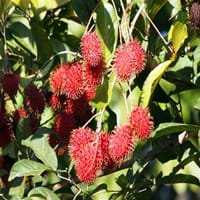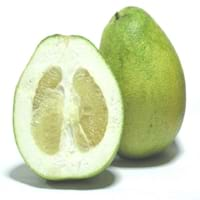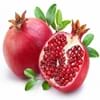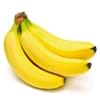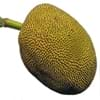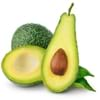Health Benefits
Anti-oxidant properties, Boosts immune system, Skin rejuvenation, Strengthening of bones
Cancer prevention, Heart care, Prevents Urinary Tract Infection
General Benefits
Antiseptic properties, Cures headache, Removes waste from kidney
Digestive aid, Fights against infections, Flu treatment, Healing of wounds, Helps in weight loss, Treatment of common cold
Skin Benefits
Hydrates skin
Anti-aging benefits, Brightens and lightens complexion
Hair Benefits
Good conditioner
Promotes longer and healthier hair, Protects hair
Allergy Symptoms
Chest pains, Rhinitis, Wheezing
Abdominal cramps, Abdominal pains, Diarrhea, Lightheadedness, Nasal congestion, Nausea, Swallowing difficulties, Swelling of mouth, tongue or lips, Vomiting
Side Effects
Unknown
Allergic reaction, Dizziness, Stomach pain
Best Time to Eat
As a snack in the late afternoon, Don't consume at night and before bed, Eat the fresh ones, avoid mixing with any other foods, don't eat after meal., Morning time (before lunch)
As a snack in the late afternoon, Don't consume at night and before bed, Eat the fresh ones, avoid mixing with any other foods, don't eat after meal., Morning time (before lunch)
Vitamin A (Retinol)
Not Available
Vitamin B5 (Pantothenic Acid)
Not Available
Vitamin B9 (Folic acid)
Not Available
Vitamin C (Ascorbic Acid)
Vitamin E (Tocopherole)
Not Available
Vitamin K (Phyllochinone)
Not Available
Lutein+Zeaxanthin
Not Available
Phytosterol
Not Available
Calories in Fresh Fruit with Peel
Calories in Fresh Fruit without Peel
Not Available
Not Available
Calories in Frozen Form
Not Available
Calories in Canned Form
Not Available
Calories in Pie
Not Available
Type
Tree fruit, Tropical
Citrus, Tropical
Season
Early summer, Early winter, Late fall, Late spring
All seasons
Varieties
Rongrien, Chompu, Rapiah, Bingjai and Lebak Bulus
Chandler, Cocktail, Cuban Shaddock, Hirado Buntan, Honey, Jaffa Red, Mato Buntan, Pomelit, Reinking, Siamese Sweet and Sweetie
Color
Coral red, Yellow
Green, Pink, Red, Yellow
Inside Color
Greyish-white
Creamy Yellow
Taste
Sour, Sweet
Juicy, Sweet
Origin
Unknown
Malaysia, South-Eastern Asia, Thailand
Soil Type
Clay, Loam
Clay, Loam, Sandy
Climatic Conditions
Humid
Warm
Facts about
- Oils extracted from its seeds is used to make soaps and candles.
- 'Rambut' means hairy in Malay.
- It makes the best hair mask.
- Seeds are edible and healthy too.
- Flowers of pomelo fruit are used to make perfumes.
- Pomelo tree wood is used for the manufacture of tool handles.
- Life of pomelo tree is around 10 years.
- Height of pomelo can be 15-20 feet.
Top Producer
Thailand
China
Other Countries
Africa, India, Indonesia, Malaysia, Philippines, Sri Lanka
Argentina, India, Israel, Mexico, South Africa, Sudan, Thailand, Turkey, United States of America
Top Importer
Singapore
Europe
Top Exporter
Thailand
United States of America
Botanical Name
Nephelium lappaceum
Citrus maxima
Synonym
Rambota
Citrus grandis
Subkingdom
Tracheobionta
Tracheobionta
Division
Tracheophyta
Magnoliophyta
Class
Magnoliopsida
Magnoliopsida
Order
Sapindales
Sapindales
Family
Sapindaceae
Rutaceae
Species
N. lappaceum
C. maxima
Generic Group
Not Available
Citrus fruit
Difference Between Rambutan and Pomelo
We might think that Rambutan and Pomelo are similar with respect to nutritional value and health benefits. But the nutrient content of both fruits is different. Rambutan and Pomelo Facts such as their taste, shape, color, and size are also distinct. The difference between Rambutan and Pomelo is explained here.
The amount of calories in 100 gm of fresh Rambutan and Pomelo with peel is 69.00 kcal and 38.00 kcal and the amount of calories without peel is Not Available and Not Available respectively. Thus, Rambutan and Pomelo belong to and category.These fruits might or might not differ with respect to their scientific classification. The order of Rambutan and Pomelo is Sapindales and Sapindales respectively. Rambutan belongs to Sapindaceae family and Pomelo belongs to Rutaceae family. Rambutan belongs to Nephelium genus of N. lappaceum species and Pomelo belongs to Citrus genus of C. maxima species. Beings plants, both fruits belong to Plantae Kingdom.
